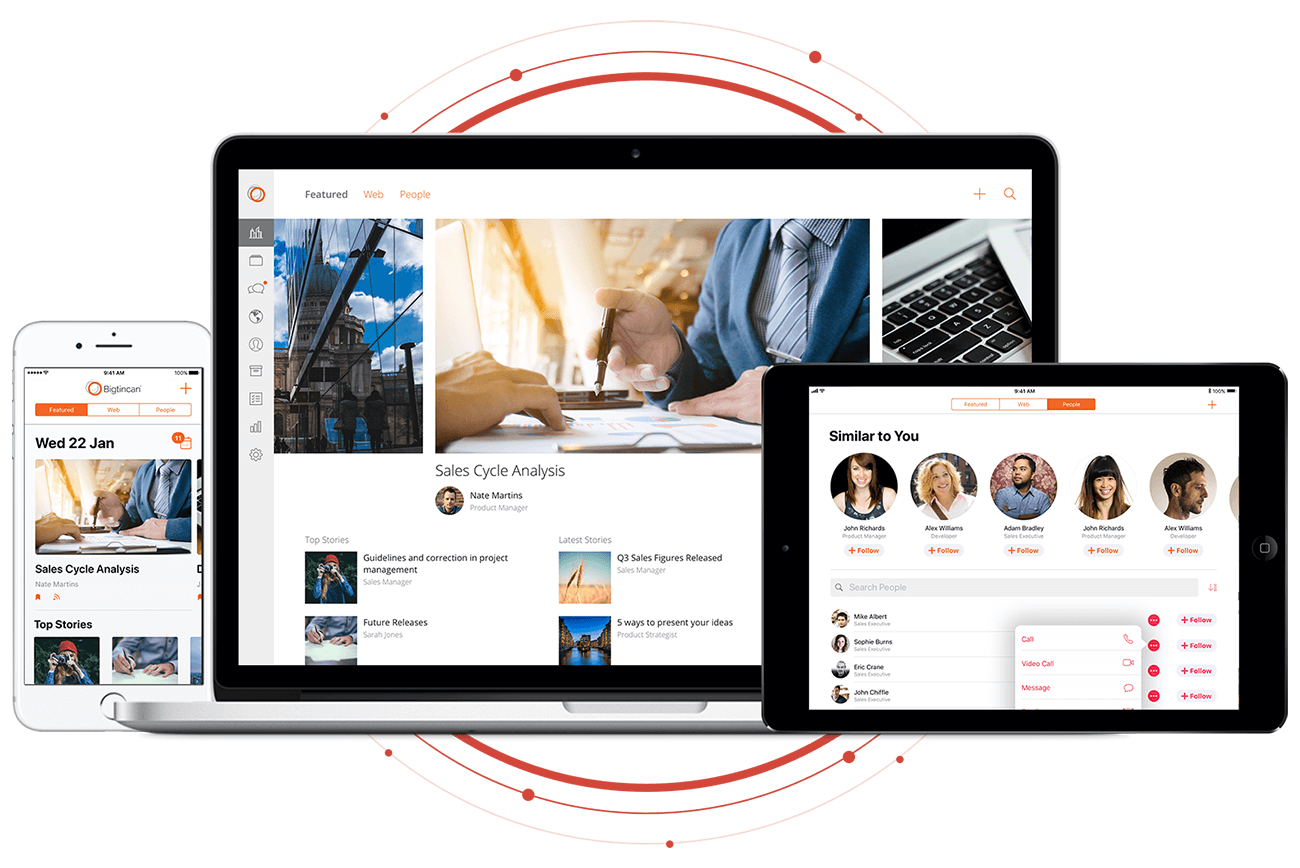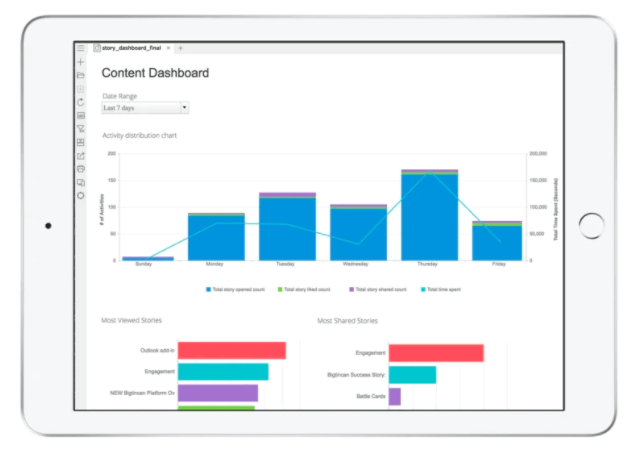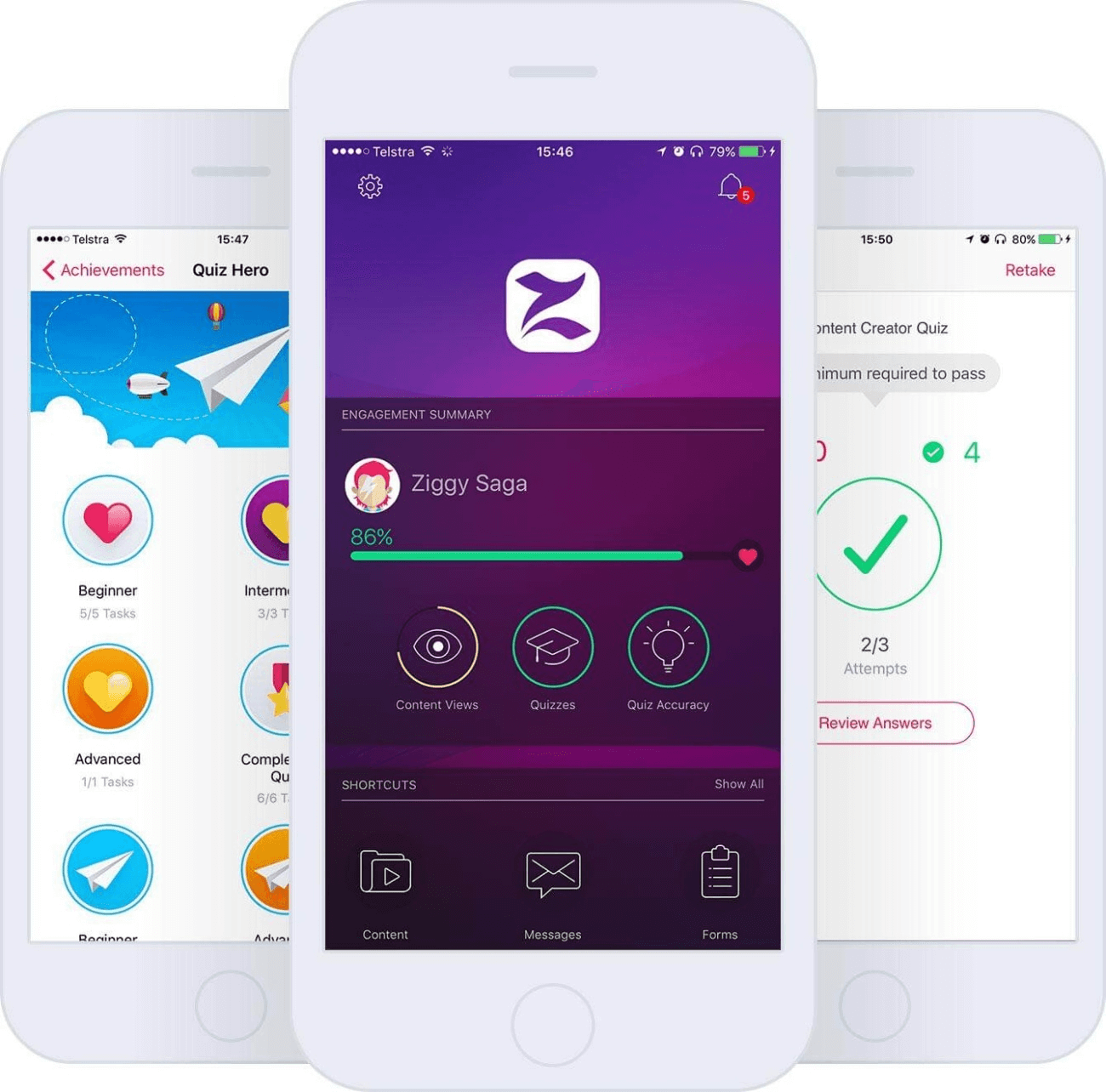Sales enablement is the process of making sales teams able to efficiently move customers through the sales process to the point where the customer can make a buying decision. So gauging whether a sales enablement strategy is effective means answering this question:
Is the sales team easily finding the product and training content they need when they need it?
This is, fundamentally, a technology and software question:
- What software is being used to share content with the sales team?
- Can reps easily find a sales deck vs. a product brochure vs. a training video?
- Do other departments have the right levels of access to create, edit, comment and distribute this content (e.g. a product engineering document from the engineering team) to the sales team?
Delivering the right content to the right people, finding the right content when you search, setting permissions so the right people can edit the right content are all dictated by software.
Therefore, in this article, we’ll discuss:
- The primary factors that interfere with sales enablement
- The four components of a successful sales enablement strategy: (1) content access, (2) training access and format, (3) engagement metrics, and (4) ease of adoption
Finally, we’ll show, in detail, how Bigtincan sales enablement software helps enterprise level organizations implement and streamline their sales enablement strategy
Want to learn more about Bigtincan and see if it’s the right fit for your organization? Request a demo today. Or skip to the section below on how Bigtincan can help organizations implement a modern sales enablement strategy.
What Is Sales Enablement?
As stated above, sales enablement is the process of making sales teams able to efficiently move customers through the sales process to the point where the customer can make a buying decision.
This includes how sales documents are shared, stored, created, and accessed. It also includes how training materials are created and managed, training format (online vs. in-person), training incentives, and anything else related to training and training materials.
These Three Foundational Supports of Sales Enablement Must Be in Place First
Before we break down the tactical steps involved in actually implementing a sales enablement strategy, we need to first explain our three truths of sales enablement so that the strategy itself is sound.
You can read our full article on this here, The Three Truths of Enablement, but in brief, these high level truths must be in place for any of the ground level sales enablement strategies and tactics to transform the organization in a meaningful way:
Truth #1: Active executive support is required
Your sales enablement projects must be aligned with an executive sponsor's goals. An executive sponsor must be someone sitting at the executive table with the CEO or someone who runs an entire division that oversees revenue generation, revenue retention, and/or risk mitigation. The executive sponsor is the sales enablement team’s ally in removing obstacles to success.
Truth #2: Sales enablement efforts must be tied to business outcomes
The sales enablement team must report metrics aligned to specific business outcomes — and a portion of their compensation must be tied to these. These KPIs can range from an increase in average contract value, increases in average deal velocity, a reduction in SaaS churn rate, or less dollars spent in litigation due to the use of non-compliant presentations.
Truth #3: The customer must be at the center of your sales enablement efforts
Every sales organization says they are customer-centric, but most have room for improvement. Ask yourself these questions to see how customer-centric your organization really is. Is the team operating on its own sales schedule or working on the customer’s purchasing schedule? How much time do your sellers spend with prospects understanding their buying process?
If your organization fails to implement these higher level changes, then any of the tactics and strategies shared below aren’t going to be as transformative as they otherwise could be.
Three Reasons Why Sales Enablement Strategies Fail: Disorganized Content, No Engagement Metrics, Archaic Training
If you’ve read through other articles on sales enablement strategy and sales enablement tools, you’ve already been bludgeoned with countless cliché phrases like “commit to creating training content to meet sales performance KPIs,” “get everyone aligned to boost the bottom line,” and “collaborate with marketing to align marketing efforts with the sales process.”
No one disagrees with these maxims, but the problem we’ve seen in enterprise level sales teams is that well-intentioned sales enablement efforts fail on execution. These sayings don’t even begin to hint at the tactics involved to make them a reality. When it comes to execution, we see these three common issues often:
Common Issue #1: Sales content is disorganized, hard to access, or difficult to use.
The first and most common issue we see is that well-intentioned sales enablement process improvements fail when the content that marketing and other departments create for sales is scattered across a bunch of different places and is hard to find and keep track of. For example, one team may put their content in Google Drive, another in Sharepoint and a third on a shared company server.
Then, because it’s not immediately obvious to reps where to find the latest version of content (e.g. whitepapers, pricing, or a sales deck), reps end up storing a local version on their own hard drives. This is a disaster from a sales enablement strategy point of view because then individual reps have customized, potentially off brand or outdated content like sales decks they’re using that the company has no control over or insight into.
The only way to solve this is to have a single location that all reps can trust will always surface the exact content they need. Ideally this solution can also make it easy to see shared documents, leave comments, and see version history.
Common Issue #2: No insight into what content is being used by reps or prospects.
In order to develop useful sales content, you need data around which content your (1) sales team uses most and (2) which documents their prospects actually engage with in the buying process. Without this information, your marketing and design teams may be spending hours of time on content that neither reps nor prospects may actually use throughout the customer journey and sales process. According to some reports, two thirds of the marketing material created for the sales team never even gets used, so the time savings can be significant.
Inversely, if you do have this engagement data, marketing and other departments creating sales enablement content can keep a laser focus on creating and improving upon the content most used by reps and most needed by prospects.
Common Issue #3: Sales training material is hard to create, hard to access, and is too long and boring.
Finally, sales training and the delivery of training content is also a component of sales enablement strategy that any sales enablement manager or sales enablement team needs to get right.
From what we see, sales training strategies fail most often because the training content and the software used to access and create that content is based on old-fashioned long form training — that is, hour long or longer training videos followed by quizzes, all of which are not updated very often.
As we discuss below, modern sales teams need access to training material that’s shorter (micro-learning) and there when they need it (e.g. on their phones, on the go), which is called just-in-time learning.
The Four Components of a Successful Sales Enablement Strategy
Whether you decide to implement your own strategy or use a sales enablement software like Bigtincan, to solve the three common pain points above, a successful sales enablement strategy must accomplish the following tasks:
#1. Makes content easy to find and access from one central hub.
Your sales reps and sales leaders should be able to find the right document and the latest version with ease, on any device, whether online or offline, and without navigating through a byzantine folder-in-folder structure.
There should be no reason for your reps to pull these files off onto their desktop or store local versions. Also, they should be able to easily find files regardless of which cloud repository they live in (Dropbox, Box, Sharepoint, Google Drive, etc.).
#2. Provides metrics on how sales reps and prospects engage with documents.
Any meaningful sales enablement program should be able to track how often documents are used by sales reps and which documents their prospects engage with. This data can be used to determine which documents are worth sharing and creating and which are not. Not only will this help sales by ensuring prospects and clients receive only the documents they need, but it will make other departments like marketing become more efficient and effective.
#3. Makes training content easy to create, bite size, available instantly, online or offline and on any device.
Training should be accessible online and offline. And it should work with any device. The training needs to be presented in a format that encourages training. Recent research suggests that strategies like microlearning improve long term knowledge retention. An effective sales enablement strategy takes the latest science into account.
There should be no barrier preventing anyone from creating content, barring any desired permissions and approvals with your sales organization. Maybe a sales rep just figured out the best way to pitch the latest product during his most recent sales conversations, and they want to share their insights with the rest of the team. They should be able to make a training video or sales document right there on the spot, whether they’re at the office or on an airplane. It should immediately be available to the people that benefit from it.
#4. Asks for as little behavioral change from employees as possible.
Asking employees to change their existing workflows, processes, and software habits is the #1 barrier to successfully implementing company-wide initiatives. Unfortunately, this is where most sales enablement software stumbles. Most software solutions require company-wide behavioral change, forcing all departments to stop using the software they’re used to, migrate data to a new platform and change existing workflows.
For example, your sales team receives documents from several different departments, and each department already has its processes in place. Your design team, for example, might use Adobe Illustrator and store their completed files in a Dropbox account unique to their workflow. They shouldn’t have to import files to a new program just because your sales team wants to implement a new strategy.
A successful sales enablement strategy will reduce as many barriers to entry as possible. If your company has twenty different departments with twenty different cloud storage solutions, your strategy should allow them to keep their existing workflows as much as possible.
For more information on driving adoption through your organization, you can read our article below:
How to Boost Adoption Rate of New Technology
Bigtincan Is Designed for Enterprise Sales Teams around the Four Components of a Successful Sales Enablement Strategy

Below we’ll discuss how Bigtincan is designed to enable enterprise organizations to satisfy all four of the criteria of a successful sales enablement strategy described above.
Bigtincan Makes Content Easy to Find and Access from One Central Hub
Within the Bigtincan software offering is Bigtincan Hub. This is a repository for documents, files, and videos. But it’s not like Dropbox or SharePoint. First off, Bigtincan Hub is fully customizable. The interface, homescreen, dashboard and more can be customized and arranged in whatever configuration works best for your team. There’s even the option for individual users to personalize their experience. The team at Bigtincan can even design the interface to match your company’s branding.

For example, above is just one example layout of a Bigtincan hub home or dashboard page based on a few key documents shown at the top (that are customized depending on the users role, department, region, and behavior history) with smaller updates (“Top Stories”) below. The layout, branding, and almost every detail of this homepage can be completely customized to what works best for your organization.
Advanced search features like AI-powered search and suggest ensures sales reps can find the information they need exactly when they need it. Not only that, but any related materials are surfaced at the same time. And, as an example, if your sales rep is in charge of the Southeast territory, the AI-powered search ensures they’ll only have to look through content related to their role and territory.

We’ll cover the details later on, but every file in the Bigtincan Hub repository could come from a different cloud storage repository across your enterprise. And all of the Bigtincan Hub content is always available offline.
In addition to the main repository, Bigtincan users can create their own personal content repositories to store and access their favorite content for their personal sales playbook. Bigtincan creates a shortcut to the original file, so there’s never any issues of replicating materials and using outdated content. The marketing department still maintains control of the original file and can set limitations, such as preventing downloads and limiting access. Whenever a file is updated, each person who has saved the file will get a notification in real-time letting them know what’s been changed so messaging stays consistent across sales operations.
In the articles below, we go into more depth on the ways that Bigtincan Hub increases sales enablement by improving access to content:
- The Best Sales Asset Management Software Helps You Find Assets Faster: An Overview of Bigtincan
- Mobile Content Management Solutions: Why Simple File Storage Is Inadequate
- Financial Services Document Management: Save Hundreds of Hours with Automation and File Organization
Bigtincan Provides Metrics on How Sales Reps and Prospects Engage with Documents
As we explain in our article The Best Enterprise Content Management Software to Empower Sales and Marketing Teams, Bigtincan provides statistics on content usage.
 In fact, you can get document-level insights for all types of content. Here are just a few examples of what you can see:
In fact, you can get document-level insights for all types of content. Here are just a few examples of what you can see:
- How many times a file has been opened, who opened it, and how it was used;
- How many times each slide or page in a document was viewed, and who viewed them;
- When during the sales cycle each piece of content was used;
- Which pieces of content are connected to the most closed deals;
- And more.
This intelligence is one of the most important features in Bigtincan because it helps you use content more effectively and empowered decision makers to determine the right sales content is being created.
For example, let’s say one file was opened 80 times, but 60 of the opens were from one rep who just used it for reference. Meanwhile, another document was only opened 20 times, but it was sent to 30 prospects, and five of them eventually turned into customers. Obviously the latter piece of content is more valuable to the buyer’s journey, but you’d only know this if proper engagement data is being collected, which Bigtincan collects.
Bigtincan Makes Training Content Easy to Create, Bite Size, Available Instantly, Online or Offline and on Any Device
Within the Bigtincan software offering is Bigtincan Learning. Bigtincan Learning offers sales reps with direct feedback tools and serves as a one-stop training platform.

In our article 12 Sales Coaching Tools for Onboarding and Upskilling Sales Reps, we discuss the ways in which Bigtincan Learning provides all the same functionality as standard Learning Management Systems — but with some major innovations added. If you already have a training system in place, Bigtincan makes the switch easy by supporting importing SCORM and other popular formats. Here’s just some of the ways Bigtincan Learning enables sales training:
- Optimized for mobile, so sales reps can train anywhere
- Designed for micro-lessons to boost knowledge retention
- Incorporates gamification and certification to boost the desire to train
- Harnesses AI to adapt training to each person’s role and suggest just-in-time learning materials, providing a individualized experience for every user
- Allows for one-on-one feedback where sales reps record practice sessions for their managers to review asynchronously
- Managers can monitor training progress on dashboards displaying key training metrics and can send assignments and design quizzes for their team
Creating new courses is intuitive with Bigtincan Learning’s course creation software. That’s because Bigtincan is optimized for both students and administrators, making it ideal for even beginners to create training content on the fly. On top of all of this, the team at Bigtincan can work with you to ensure the training platform looks and feels just right for your brand.

In the articles below, we discuss Bigtincan Learning in more detail and share a success story of customizing the Bigtincan app for two global brands:
- The Best Enterprise LMS 2.0 for Training and Knowledge Retention
- Best Mobile LMS: 4 of the Best Options for Enterprise Organizations and SMEs
- The Best Retail LMS for Enterprise Brands: How to Onboard Employees Quickly and Boost Engagement
- Two Global Brand Digital Retail Transformation Case Studies: Lessons & Challenges
Bigtincan Requires as Little Behavioral Change as Possible
As we’ve repeatedly stated, requiring too much behavioral change is the #1 barrier to successful adoption of company-wide initiatives. Bigtincan makes adoption and buy-in effortless by syncing with your existing software solutions.
Bigtincan offers an industry leading 100+ out-of-the-box integrations from the most used CRMs like Salesforce, to traditional learning management systems (LMS) and content management tools.
Additionally, Bigtincan integrates with just about every cloud repository, allowing you to sync all of your content with Bigtincan regardless of where it might live. This ensures that departments across your enterprise can maintain their usual workflows as you implement your sales enablement strategy.
For marketers, Bigtincan integrates with various marketing automation platforms such as Marketo, and Bigtincan for Adobe offers a unique way to leverage investments in Adobe Acrobat, Experience Manager, and Indesign.
But the integrations don’t end there. Our Rest-based API and CSV data export allows you to connect Bigtincan to additional sales and marketing software for a connected view of all content, bringing even more value to your current software investments.
Conclusion
Bigtincan software supports the successful implementation of a sales enablement strategy that supports the sales readiness and sales productivity of leading organizations. It makes content easy to find and create, boosts training efficiency and usage, provides statistics that improve sales efficiency and effectiveness while enabling better sales content creation, and it removes as much friction as possible to ensure successful company-wide adoption for team members.
If you’d like to learn more about how Bigtincan can help your sales or other enterprise teams manage and administer learning objects more effectively, request a demo today.
